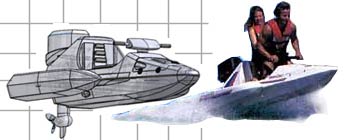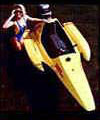|
 At rest, HydroRunner sits low in the water like a Cheetah poised in deep
grass. Squeeze off a handful of throttle and she leaps onto plane and
skims across the water at 40 mph. On plane, the tunnel-hull design gives a sure-footed stability that is
unmatched by PWCs with conventional vee hulls. Turns are flat like a hydroplane. Stability comes
from the super-wide beam, which is camouflaged by
her patented tri-hull design. In reality, HydroRunner's hull is about
half as wide as it is long. At rest, HydroRunner sits low in the water like a Cheetah poised in deep
grass. Squeeze off a handful of throttle and she leaps onto plane and
skims across the water at 40 mph. On plane, the tunnel-hull design gives a sure-footed stability that is
unmatched by PWCs with conventional vee hulls. Turns are flat like a hydroplane. Stability comes
from the super-wide beam, which is camouflaged by
her patented tri-hull design. In reality, HydroRunner's hull is about
half as wide as it is long.
 Unlike conventional personal watercraft, HydroRunner does not heel into turns. Instead, she turns flat, more like a hydroplane. For a quick turn, back off on the throttle, crank the handlebars to one side, then apply full throttle. HydroRunner will swap ends and head off in the opposite direction almost within her own length. At high speeds, wake is normally taken with a giant, airborne leap. But hit a wake at speed on the down side of a jump and she'll go straight through it, rather than over it. Unlike conventional personal watercraft, HydroRunner does not heel into turns. Instead, she turns flat, more like a hydroplane. For a quick turn, back off on the throttle, crank the handlebars to one side, then apply full throttle. HydroRunner will swap ends and head off in the opposite direction almost within her own length. At high speeds, wake is normally taken with a giant, airborne leap. But hit a wake at speed on the down side of a jump and she'll go straight through it, rather than over it.
Power can come from any short-shaft outboard of 25 to 30 horsepower. The throttle lever is a standard bicycle brake lever attached by a cable to the engine's throttle mechanism. Releasing the throttle lever returns the engine to idle. A standard shut-off lanyard is attached to the rider's life jacket so the engine will immediately stop in the event of an unexpected departure from cockpit. During tests, the engine stops as the rider is leaving the cockpit and HydroRunner comes to rest only 3 or 4 meters away. The prototype was put through the US Coast Guard safe-powering pylon tests to document that she can handle the high power. Every new high-powered small watercraft also has to pass the same tests.
Most of the expense of building her is in the cost of the engine. New, the engine can run $3,000 or more. A used engine can be purchased for $600 - $800. Figure another $700 for enough plywood, fiberglass, and fixtures to finish the craft. HydroRunner is made primarily of 1/2-inch and 1/4-inch plywood, which is then covered with a layup of fiberglass. Most of the fixtures are standard boat items.
The tunnel hull wetted area was designed by Ron Ehde. If you're a fan of tunnel hulls, you've probably heard his name Ron designed the tunnel hull boats for Eliminator Boats. And his tunnel hulls held the National Championship in drag boat competitions for ten years. He was invited to join the project early on, as soon as Popular Mechanics decided they wanted to go ahead with the HydroRunner concept. Ron is undoubtedly the nation's top tunnel hull designer.
Plans include lots of photos and detailed drawings and instructions.
Specifications |
Length: 105-1/2 inch
Width: 54 inch
Height: 26-1/2 inch
Empty Weight: 350 lbs
Engine: 25 hp to 30 hp short-shaft outboard
Top Speed: 45 mph
Construction: Fiberglass reinforced with wood monocoque
Build Time: 125-150 hours |
|
![]()








 Unlike conventional personal watercraft, HydroRunner does not heel into turns. Instead, she turns flat, more like a hydroplane. For a quick turn, back off on the throttle, crank the handlebars to one side, then apply full throttle. HydroRunner will swap ends and head off in the opposite direction almost within her own length. At high speeds, wake is normally taken with a giant, airborne leap. But hit a wake at speed on the down side of a jump and she'll go straight through it, rather than over it.
Unlike conventional personal watercraft, HydroRunner does not heel into turns. Instead, she turns flat, more like a hydroplane. For a quick turn, back off on the throttle, crank the handlebars to one side, then apply full throttle. HydroRunner will swap ends and head off in the opposite direction almost within her own length. At high speeds, wake is normally taken with a giant, airborne leap. But hit a wake at speed on the down side of a jump and she'll go straight through it, rather than over it.